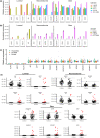Liquid biopsy-based targeted gene screening highlights tumor cell subtypes in patients with advanced prostate cancer
- PMID: 36172886
- PMCID: PMC9652435
- DOI: 10.1111/cts.13372
Liquid biopsy-based targeted gene screening highlights tumor cell subtypes in patients with advanced prostate cancer
Abstract
Prostate cancer (PCa) clinical heterogeneity underscores tumor heterogeneity, which may be best defined by cell subtypes. To test if cell subtypes contributing to progression can be assessed noninvasively, we investigated whether 14 genes representing luminal, neuroendocrine, and stem cells are detectable in whole blood RNA of patients with advanced PCa. For each gene, reverse transcription quantitative polymerase chain reaction assays were first validated using RNA from PCa cell lines, and their traceability in blood was assessed in cell spiking experiments. These were next tested in blood RNA of 40 advanced PCa cases and 40 healthy controls. Expression in controls, which was low or negative, was used to define stringent thresholds for gene overexpression in patients to account for normal variation in white blood cells. Thirty-five of 40 patients overexpressed at least one gene. Patients with more genes overexpressed had a higher risk of death (hazard ratio 1.42, range 1.12-1.77). Progression on androgen receptor inhibitors was associated with overexpression of stem (odds ratio [OR] 7.74, range 1.68-35.61) and neuroendocrine (OR 13.10, range 1.24-142.34) genes, while luminal genes were associated with taxanes (OR 2.7, range 1.07-6.82). Analyses in PCa transcriptomic datasets revealed that this gene panel was most prominent in metastases of advanced disease, with diversity among patients. Collectively, these findings support the contribution of the prostate cell subtypes to disease progression. Cell-subtype specific genes are traceable in blood RNA of patients with advanced PCa and are associated with clinically relevant end points. This opens the door to minimally invasive liquid biopsies for better management of this deadly disease.
© 2022 The Authors. Clinical and Translational Science published by Wiley Periodicals LLC on behalf of American Society for Clinical Pharmacology and Therapeutics.
Conflict of interest statement
The authors declared no competing interests for this work.
Figures





References
Publication types
MeSH terms
Substances
Grants and funding
LinkOut - more resources
Full Text Sources
Medical

